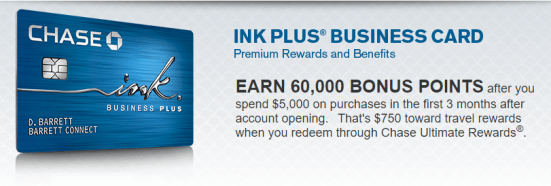
There are a lot of
Do you mostly fly on one airline? Or do you like the flexibility of buying through a rewards program or transferring points to different airlines? Maybe you make a lot of purchases in a certain category, like gas or groceries? All of these things and more can influence your decision and determine which card is best for you.
Whatever you decide to get in the end, there are some key characteristics of rewards cards that you should consider before applying. Below is a brief outline of what to look for in card. I’ve broken it down into the welcome bonus, flexibility, earning potential, unique benefits, cardholder perks and the annual fee.
Welcome Bonus
Bigger is better, right? While that’s mostly true, there are a few other things you need to keep in mind. The larger intro bonuses, such as the 60,000 points you get with the Chase Ink Plus Business card, generally require you to meet a higher minimum spend. For example, you have to spend $5,000 in three months to get the Ink Plus bonus. That’s $1,667 a month.

It’s worth taking a look at your spending habits to see if you can reach the minimum spend before applying for a card. If you can’t, then you should consider a card that doesn’t require you to spend as much. Or you could plan to make a big purchase or two soon after getting the card.
Just because
Flexibility
Some cards give you a lot more options for spending your points or miles. Co-branded airline cards, for instance, only allow you to use miles to buy flights through one airline. If you’re thinking of going this route, keep in mind that some airlines offer more options than others.
The big three domestic carriers—Delta, United and American—are all members of a major alliance. That means you can buy award flights on a lot of different airlines directly through Delta, United and American.

Other carriers, such as Alaska Airlines and Virgin America, have some solid partners, but they don’t typically have as many options as alliance members. Low cost airlines, like Southwest and Frontier, usually allow you to only buy awards on their own flights.
By far the most flexible cards are those that belong to major rewards programs, such as Chase Ultimate Rewards, American Express Membership Rewards and Citi ThankYou. With cards that are a part of those programs, you can transfer your points to a variety of airlines or buy travel directly through their online travel centers.
Membership Rewards has the most transfer partners with 16, while ThankYou has 12 and Ultimate Rewards has six. You can transfer points with any of those programs to carriers in the big three airline alliances: SkyTeam, the Star Alliance and oneworld.
Keep in mind that not all cards issued by American Express, Citi and Chase give you access to their respective rewards programs or airline transfer partners. The Chase Freedom and Citi ThankYou Preferred cards don’t, for example, unless you have another card that’s part of their programs, like the Chase Sapphire or Citi ThankYou Premier.
Earning Potential
All rewards cards give you at least one point or mile per dollar spent. Most also give you bonus points for purchases in certain categories. Co-branded airline cards often give you double miles for purchases made with the airline, but many non-airline specific cards will give you more for certain purchases.
The Chase Sapphire Preferred, for instance, gives you double points on all travel purchases and at restaurants. The Premier Rewards Gold Amex card, a premium, high-annual-fee card, has an excellent earning potential of triple points on airfare and double points at restaurants, gas stations and supermarkets.
When you’re thinking about the earning potential of a card, it’s important to consider how you plan to use it. Earning five points for every dollar spent on office supplies with the Chase Ink Plus business card sounds amazing, but it is useless if you don’t buy business supplies.
Unique Benefits
Co-branded airline cards typically offer some carrier-specific perks to cardholders. They usually include free checked bags, priority boarding and in-flight discounts. The better cards, like Alaska Airlines Visa Signature, will also give you an annual companion ticket.
If you step up to a premium, top-of-the-line card, like Delta Reserve or Citi Prestige, you can expect to get more, like free lounge access, airline fee credits and TSA PreCheck/Global Entry.

Premium cards that are part of rewards programs and not co-branded with a specific airline are more flexible, and typically give you access to a wider variety of lounges and discounts on travel purchased through their program. Co-branded airline cards, on the other hand, may offer you the opportunity to earn miles towards elite status by reaching certain spending criteria.
Mid-level cards typically offer some benefits, though not as many or as generous as you’d get with the premium cards. If you look at the Citi ThankYou card lineup, for example, this becomes clear. ThankYou Preferred is their base, no-annual-fee card. It offers double points on some purchases, but doesn’t allow you to transfer points to frequent flyer programs.
The ThankYou Premier card, on the other hand, gives you triple points for some categories and full access to the ThankYou program, including transfer partners. You’ll also get a 25 percent bonus on travel purchased through the ThankYou Travel Center.
The ThankYou Prestige card gives you all of that, plus deeper discounts on ThankYou Travel Center purchases, lounge access, an airline fee credit, free nights at hotels and more.
Cardholder Perks
Most of these cards will come with the basics: purchase protection, zero liability and car rental insurance are pretty standard. Many will even come with travel accident insurance, lost baggage insurance and no foreign transaction fees. The more expensive cards usually also come with some sort of personal assistance hotline and a concierge service to help you book your travel.
If these perks are important to you, be sure to read the fine print and consider giving the card company a call to be sure you get the benefits you want.
Annual Fee
You shouldn’t necessarily let a big annual fee keep you from getting a card. Be sure to weigh the net value of the card against the fee. For instance, the Delta Reserve card has a hefty $450 annual fee. But you can more than pay for that with the card’s free companion ticket, which allows you to take one person with you on any domestic flight in economy or first class. A transcontinental flight in first class, for example, can cost thousands of dollars. And don’t forget the free lounge access, too.
Which card should you get?
When considering your next card, try to be as objective as possible about your current credit card spending and what you hope to get out of your points or miles. What card is going to earn you the most? Which benefits are you actually going to use? And which airline will get you to your dream destination? Choose wisely and travel often.
